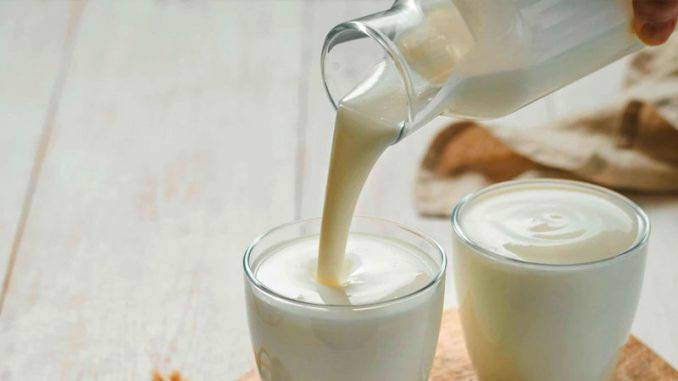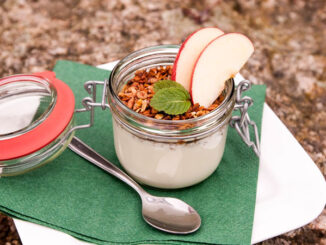
Although milk Kefir looks similar and may even taste similar to yogurt, there are many differences between these fermented dairy products, including how they are made and the types of bacteria they contain.
The first and most apparent difference between Kefir and yogurt is in their “look and feel”.
Yogurt has a thick, jelly-like consistency, and its variety – the Greek yogurt – is even thicker.
Kefir resembles a slightly diluted yogurt with a creamy texture. Unlike yogurt which generally can be eaten with a spoon, Kefir is rather perceived as a thick, creamy beverage.
Preparation
The next fundamental difference between milk Kefir and yogurt is that kefir microorganisms are mesophilic cultures, which means that they thrive and coagulate (thicken) milk at room temperature.
Unlike Kefir, yogurt’s microorganisms are thermophilic, which means they need higher temperatures to ferment and coagulate (thicken) milk.
Typically, yogurt starts to coagulate at around 30-35° Celsius (85-95° Fahrenheit) or even higher temperatures – between 42° and 45°C (108° and 113°F). Often special appliances called “yogurt makers” are used to make homemade yogurt. These “yogurt makers” are electric devices able to maintain a constant high temperature of around 42°C (108°F) required by the yogurt bacteria to ferment the milk.
Another fundamental difference between Kefir and yogurt is the starter culture they need for their fermentation.
For the preparation of homemade yogurt, only a small portion of already fermented yogurt is required. The fermented yogurt is then mixed with the hot fresh milk and serves as a starter culture for the newly brewed yogurt.
On the other hand, to prepare homemade Kefir you will either need milk Kefir grains, also called Kefir SCOBY, or special Kefir starter cultures that are in fact lyophilized Kefir cultures.
Milk Kefir grains can either be obtained from other Kefir lovers or bought from online stores like Amazon.
The lyophilized Kefir starter cultures can only be bought from online stores like Amazon and they are normally intended for single use only. Unlike the lyophilized starter cultures, Kefir grains can be used virtually forever provided that they are regularly fed with fresh milk.
As we already said, fermentation of Kefir requires the presence of Kefir grains, also called SCOBY, representing a symbiotic colony of bacteria and yeast with the look of white cauliflower-like formations. These grains are reusable, and in addition to being used indefinitely, they also grow and multiply with each fermentation batch.
On the other hand, the Kefir starter cultures have the advantage to provide more consistent results throughout the batches, and they are relatively easier to handle.
Simply put, preparation of Kefir at home is much easier and straightforward than yogurt. You just need to mix the kefir grains (SCOBY) with cold fresh milk and let it ferment at normal room temperature for 12 to 24 hours.
Bacterial cultures and health benefits
Milk kefir and yogurt are fermented dairy products, and the number and variety of beneficial probiotic bacteria they contain are crucial for their nutritional and health-promoting qualities.
Both milk kefir and yogurt contain lactic acid bacteria (LAB), but this is actually their only common trait. All the rest is different.
The most important nutritional difference between yogurt and Kefir is that Kefir contains considerably more probiotic bacteria than yogurt.
Yogurt typically contains only two main types of probiotic lactic acid bacteria: Lactobacillus delbrueckii subspieces bulgaricus (known as Lactobacillus bulgaricus), and Streptococcus thermophilus.
In some commercially available yogurt brands, extra lactobacilli and bifidobacteria strains are artificially added to yogurt to enhance its probiotic properties and increase the number of colony-forming units (CFU’s). Still, nevertheless, the number of probiotic bacterial strains in yogurt rarely exceeds 5 or 6.
On the other hand, milk Kefir is the richest source of probiotics humankind has ever encountered, and its health benefits have been known for hundreds of years.
Several scientific studies, including this Research on Health Promoting Characteristics of Kefir, found that Kefir may contain up to 50 different types of probiotic bacteria and yeasts.
An indicative list of the probiotic bacteria kefir provides can be seen in this table.
As a result of such an exceptionally high probiotic content, Kefir has a wide range of health benefits, unmatched by any other fermented product.
Some of these undisputed health benefits of Kefir are:
- Kefir improves digestion and relieves constipation.
- Kefir is a powerful immune system modulator.
- Kefir has powerful antibacterial properties.
- Kefir improves bone strength.
- Kefir controls cholesterol levels and lowers blood pressure.
- Kefir lowers blood sugar levels and is a valuable support treatment for diabetes.
- Kefir is supposed to have anti-carcinogenic effects.
- Kefir contains less lactose than fresh milk and is better accepted by lactose-intolerant patients.
- Kefir has an anti-allergic effect and can inhibit the symptoms of allergies and asthma.
- Kefir can help weight control.
- Kefir can slow down the consequences of aging.
- Kefir has a soothing effect on the nervous system.
Another significant difference between Kefir and yogurt is that Kefir bacteria can colonize the gastrointestinal tract and stay there longer.
Here is the clue: the beneficial bacteria of yogurt can keep the digestive tract in good shape and provide friendly bacteria for a healthy gut, but they pass through the digestive tract and do not stay there. That is why they are called “transient bacteria,” and so, to keep yogurt’s probiotic effect, you just need to take new portions of yogurt continuously.
Unlike yogurt, the bacteria of Kefir are not transient. They do not only pass through but actually colonize the gastrointestinal tract and stay there considerably longer.
Kefir also contains a large number of yeasts that are not present in yogurt.
Kefir contains considerably more probiotic cultures than yogurt! Kefir may have up to 50 live and active bacterial strains while yogurt may contain only up to 5 or 6 probiotic cultures.
Nutritional facts
| Per 100 g. (3.5 oz) | Plain low-fat Kefir | Plain low-fat yogurt |
| Calories | 43 | 63 |
| Protein | 3.79 g | 5.25 g |
| Fat | 1.02 g | 1.55 g |
| Carbohydrates | 4.77 g | 7.04 g |
| Total sugars | 4.61 g | 7.04 g |
Summary
We can sum up the differences between Kefir and yogurt in three main directions:
- Kefir contains considerably more probiotic bacteria than yogurt. While yogurt may have a maximum of 5 or 6 probiotic bacterial strains (most commonly Streptococcus thermophilus and Lactobacillus bulgaricus), milk Kefir can contain up to 50 different probiotic bacteria, including Lactobacillus kefir, Lactobacillus kefiranofaciens, etc. Moreover, Kefir also contains many yeasts, while yogurt doesn’t have any yeast.
- The probiotic bacteria of yogurt are transient, meaning that they pass through the gastrointestinal tract and get then discarded. Their beneficial effects only last as long as they stay in the GI tract. Unlike yogurt, kefir bacteria can colonize the gastrointestinal tract and tend to stay there much longer.
- The probiotic bacteria of Kefir are mesophilic, which means that they coagulate (ferment) milk at average room temperatures. On the other hand, yogurt bacteria are thermophilic, which means they need higher temperatures to thrive and ferment: about 37° Celsius (100° Fahrenheit), making Kefir preparation more straightforward and accessible than yogurt.
You can find more information on this topic in our article “Difference between buttermilk, yogurt, and kefir.”
Related questions
- Can I use store-bought Kefir as a starter for homemade Kefir? No. The Kefir you will find in the grocery stores does not contain enough living bacteria to inoculate the milk and prepare homemade Kefir. The preparation of Kefir at home requires the presence of Kefir grains or special lyophilized starter cultures.
- Can I use both yogurt and Kefir starters to prepare a homemade dairy probiotic? Yes, but the resulting product is unlikely to be better. In case the fermentation is carried out at normal room temperatures, the bacteria of yogurt will not develop and spread. If the fermentation is carried out at the higher temperatures needed by the yogurt bacteria, this will lead to an over-fermentation of Kefir grains.
Related resources
- What is milk Kefir?
- Kefir benefits
- What are probiotics?
- What are microbiome and microbiota?
- Kefir pros and cons
- Can Kefir help with high blood pressure?
- Kefir and lactose intolerance
- Can Kefir help with antibiotics?
- Can Kefir help with acid reflux?
- Kefir and IBS
- Can Kefir help SIBO treatment?
- Is Kefir safe during pregnancy?
- Is Kefir safe while breastfeeding?
- Difference between buttermilk, yogurt and kefir



